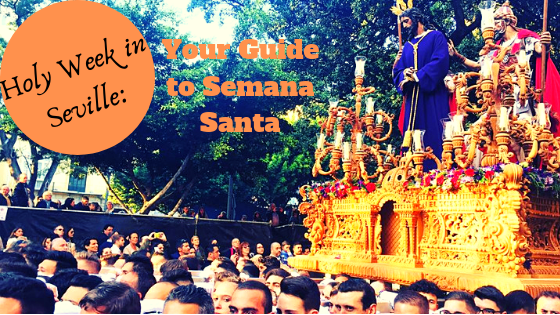HOLY WEEK IN SEVILLE: YOUR GUIDE TO SEMANA SANTA

One of the biggest cultural events in Seville is Semana Santa, or Holy Week. During this week, the city’s population swells as people come from all over the country to witness this cultural tradition. If there’s one thing that Spain does right it’s celebrations and festivals, and Semana Santa is no exception. Here’s your guide to Holy Week in Seville so you can take part just like a local!
What is Holy Week in Seville?
Semana Santa is a week-long celebration in preparation for Easter Sunday. This tradition dates all the way back to the Middle Ages, and is an important time of the year for the Catholic Church. More than 100 churches participate in penitent processions across the city, which differ from somber and sorrowful to beautiful and joyful, depending on the day. These processions recount the events of the Passion of the Christ leading up to Easter Sunday. Brotherhoods of the churches dress in traditional clothing and carry carved, wooden figures throughout the streets. These figures and floats are a sight to behold as the streets are flooded during Holy Week in Seville. To really understand this special time, there’s some lingo that you should know to help you navigate the celebrations.
Semana Santa vocab 101
To better understand all the goings-on in Seville during Holy Week, here are a few handy words that you’ll most likely hear throughout the week.
- Hermandad – a religious brotherhood. They can also be called cofradías and each one takes part in a procession during holy week.
- Pasos – floats with religious sculptures. Members of the various hermandades carry the pasos down the streets of Seville. Each paso is unique to its brotherhood, as they are passed down through generations, some even centuries!
- Trono – another name for the pasos. In addition to religious statues, they often include candles, feathers, flowers, and other decorations.
- Nazareno – people that talk part in the processions wearing the traditional robes and garments. The garments are long robes that touch the ground and the colors often correspond to the brotherhood. They often walk barefoot in the streets as a sign of penance and piety, carrying candles.
- Capirote – part of the traditional nazareno clothing. This is the tall, pointed hood that covers the face entirely except for two eye holes.
- Costalero – members of the brotherhood who help carry the pasos. Traditionally men, they practice throughout the year for this event, as it takes strength and endurance to carry the pasos.
- Saeta – a haunting, yet beautiful, song sung to the Virgin Mary from a balcony during a procession.
See more: Insider Secrets to the Most Popular Drinks in Seville
Semana Santa activities
Processions run throughout the day and night for 10 days, as follows. Viernes de Dolores (10 days before Easter), Sábado de Pasión (9 days before Easter), Domingo de Ramos (Palm Sunday), Lunes Santo (Monday), Martes Santo (Tuesday), Miércoles Santo (Wednesday), Jueves Santo (Maundy Thursday), Viernes Santo Madrugada (very early morning Good Friday), Viernes Santo (Good Friday), Sábado Santo (Holy Saturday), Domingo de Resurrección. You can find a copy of the year’s official program online, or at many hotels and bars. Each of the 60 participating hermandades has a scheduled time for them to leave their church and march through the streets.
The processions are often accompanied by marching bands playing various instruments to accompany the walk. Women often sing when the Virgin Mary passes by as a sign of love and adoration. Notice the attire during the week, on Good Friday people wear black, especially women who wear black lace veils held in place with beautiful combs. Seeing the processions, hearing the music, and smelling the unforgettable aroma of incense in the air is an experience that you’ll never forget. Holy Week in Seville is the most magical celebration of the year, apart from the Feria de Abril. You’ll notice that during this week the restaurants and tapas bars will be packed as people get a bite to eat during the processions!
How and where to see the processions
Many locals in the city center rent out their coveted terraces for those that want a birds-eye view over the streets. For those that are quite serious about Holy Week in Seville, they buy official seats, called palcos, way in advance to get the best views. As these are for the most serious residents, you’ll probably want to see the processions like the average person, just out on the street.
Many of the processions last for hours, so don’t worry about seeing it at its starting or end point. As long as you can catch a procession during its route, you’ll get a good look. Try to find them in smaller streets along the way instead of on the main roads. This way, you’ll get a better look up close. It’s known among the locals that the Triana neighborhood has especially beautiful and moving processions, and you’ll get an unforgettable view from the famous Triana bridge.
If you’re spending Holy Week in Seville, come join Food Lover Tour on an unforgettable culinary adventure to really see the city!
